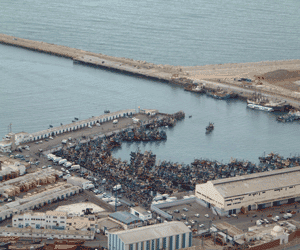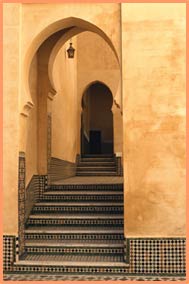|
Europeans
in Morocco- the coastal presence
In
1960, a great earthquake shook Agadir, ridding the landscape of
anything that may have stood in Leo's days. Today, what was once
the emplacement of the 'old town' is nothing but a pile of rubbles
sitting atop a hill, right outside modern day Agadir.
The 35,000 inhabitants whose life was so seriously
threatened in February 1960 would be shocked to see the agglomeration
which now houses over 300,000 inhabitants: the beachfront is busy
with sprawling hotels and restaurants, Agadir's three ports are
home to much of Morocco's exporting activity and the surrounding
country side feeds tons of tomatoes, oranges and other produce
to the world.
In many ways, Agadir is a European gateway
to Morocco.
|
 The
bustling fish port and market in Agadir
The
bustling fish port and market in Agadir |
European presence in Agadir antedates this influx of tourism: long before
hordes of German and French vacationers arrived in search of a bit of
sunshine not too far from home, the Portuguese claimed Agadir and its
surroundings for selfish reasons of their own. In Leo's days, the Portugese
were at the height of their presence in Morocco, controlling much of the
Mediterranean and Atlantic Coast. On the Atlantic, Agadir (known as Santa
Cruz de Aguer- probably a derivative of the Berber word Agadir, meaning
community barn, a building where all members of a given village used to
store grains) was one of the furthest South "frontieras"
(Portuguese enclave) and had been built by a Portuguese nobleman,
Joao Lopez de Sequeira, who personally paid for all expenses. This fortified
port was attached to the more official Portuguese presence at Massa, established
in 1497.
The internal conflicts tearing Morocco apart
made it difficult for any sovereign to take these ports away from the
Portuguese When writing about Agadir, Leo mentions a failed attempt by
the local ruler to re-conquer the fortress. In 1511, the Moroccans laid
siege to the fortified place, and lost many men in battle, but returned
home, vanquished. Leo writes that despite this defeat, the nearby populations
did not abandon the hope of recuperating these lands someday. Led by the
man who would later become the first Sultan of the Saadien dynasty, they
waited patiently, gathering men and forces for upcoming battles:
| "When
I left the Cherif's court ( Cherif is a name given to any descendant
of the Prophet, Muhammad), he had gathered more than 3000 horsemen
and a great many footmen, along with huge quantities of war materials."
(92) |
Leo's words
seem to presage the victories that awaited the Moroccans only a few years
later. Had the Portuguese read his words when they were written in the
1520s, they may have better anticipated the change in fortune...
At the height of their North African power, the Portuguese
controlled all but 2 of Morocco's main ports (Sale, the port closest to
Rabat, was one of these exceptions). However, starting 1540, the rise
of a unified Morocco under Saadien power spelled the end of Portuguese
coastal dominance. Agadir was re-conquered by Moroccan troops in 1541,
15 years after Leo finished writing his book.
|

